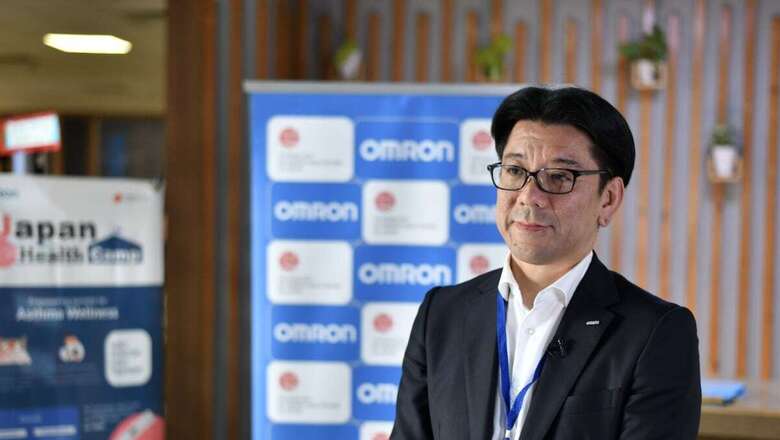
views
Omron, a Japanese manufacturer of medical devices, is experiencing record sales of blood pressure monitors in India after the Covid-19 pandemic, the company’s chief told News18. This surge is attributed to increased awareness of medical conditions, especially the importance of monitoring blood pressure.
In an exclusive interview with News18, Tetsuya Yamada, managing director of Omron Healthcare, said that India has become the company’s fourth-largest market surpassing Brazil. “Our headquarters prioritise India as a key market for future investments because of its high growth potential. We believe India could soon surpass other countries in our global rankings.”
Yamada said that the Indian market is projected to grow manifolds given the large population and the increasing prevalence of hypertension.”
During the COVID-19 pandemic, he said, the company’s revenue spiked due to heightened health awareness. “After COVID, our sales doubled in India. Covid has been an eye-opener for many people who started taking their health seriously.”
Yamada, at the company’s Gurugram office, told News18 that “the government’s messaging around chronic diseases such as hypertension and diabetes increasing the risk of severe COVID-19 led to a surge in demand for blood pressure monitors.”
This trend continues, he said, adding that Omron has experienced double-digit growth in India since 2021, with sales doubling compared to pre-pandemic levels. However, Yamada did not disclose the actual numbers.
Kyoto, Japan based Omron claims that in India, only 5 per cent of hypertensive patients use BP monitors at home, compared to 20 per cent in countries like Brazil. “However, as India’s economy is growing, income levels are growing, we expect penetration rates to rise to 10 per cent in the coming years.”
The company says that its long-term target is to achieve a “20 per cent penetration rate in India, similar to Brazil.”
Rising number of BP patients, India is a big future market
The company anticipates rapid growth in India, particularly due to the “rising number of hypertension patients” and the overall market’s potential. “Comparatively, other mature markets like Japan, the US, and the EU are growing slower, around 3-5 per cent, while India is seeing double-digit growth,” Yamada said.
Yamada said that with 22 crore hypertension patients in India, the company sees immense potential for growth. “Our mission is to help reduce the occurrence of cardiovascular events such as strokes, heart attacks and improve the quality of life for people suffering from chronic pain or respiratory issues,” Yamada added.
However, he sees a significant shortage of specialists in India, especially cardiologists. “For instance, across India, there are only about 5,500 cardiologists. This translates to less than one cardiologist per 100,000 people,” he said.
In contrast, he said, in countries like the US and Japan, they have around 10 cardiologists for the same population size. A similar situation can be seen with paediatricians handling asthma cases.
“We aim to close this gap through the use of digital blood pressure (BP) monitoring devices and other home healthcare solutions,” he said while adding that “particularly in rural areas, where patients cannot frequently visit hospitals, continuous health monitoring at home could help detect health issues early on. This way, patients can seek medical treatment before their condition worsens.”
Make in India push brings first manufacturing plant
Omron is currently constructing a factory in Chennai which will be operational by the end of fiscal year 2025 or early 2026. While presently, the company is importing its products from Vietnam, the upcoming facility in India will begin production with blood pressure monitors and eventually expand.
“The decision to build this factory was driven by growing demand in India and limitations in the existing supply from Omron’s Vietnam factory, which also serves markets in the US, Europe, and Asia-Pacific,” Yamada said.
Initially, the Chennai factory will focus solely on the Indian market. However, in the future, the company plans to explore exporting to nearby regions like the Middle East and Africa, where it would be more efficient to export from India than from Vietnam.
“The Tamil Nadu government offered a very attractive incentive plan, in line with India’s broader “Make in India” initiative. This has been a significant factor in OMRON’s decision to open the factory in Chennai,” he said.
Omron Healthcare was established in India in 2010 and by the end of the current fiscal, it expects total global sales to reach around 150 billion Japanese yen or Rs 8,500 crore. India currently represents 3 per cent of this revenue (Rs 255 crore).
Digital BP machine is the top-selling product from the company’s portfolio in India with 64 per cent of sales followed by nebulizers (15%), thermometers (7%), TENS devices or electrical nerve stimulators for relieving muscle stiffness and pain (4%) and body composition monitors (4%).
Rural, local push is next focus
Geographically, the company is focussing on expanding beyond metro cities into tier 2 and tier 3 cities. “By 2024, we aim to significantly increase our footprint across India,” Yamada said.
“Tier 2 and tier 3 cities present unique challenges, such as distribution network issues and affordability concerns. Pharmacy shops in these areas hesitate to stock expensive products. To address this, we are implementing region-specific marketing strategies,” he added.
On being asked if the company plans to reduce prices to lure rural consumers, Yamada said, “India is one of the lowest-priced markets for our devices globally.”
“Our BP monitors start at Rs 1,700 – Rs 1,800, but competitors offer lower prices. Despite this gap, we hold a 40-50 per cent market share in BP monitors. We are working to keep prices as affordable as possible, but this is our current range,” Yamada said.




















Comments
0 comment